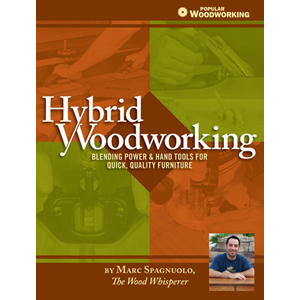
Review of Hybrid Woodworking, by Marc Spagnuolo - Book Review
by J. Norman Reid
Delaplane, VA
In today's world of woodworking, we seem to be under the gravitational pull of two opposing moons. One is the undeniable lure of the predictability and productivity of power tools. Increasingly, however, we find ourselves seduced by the silence and stealthy precision of working wood by hand. Each camp has its advocates and we may find ourselves chided as "Normites" or "Neanderthals." But do we really need to adhere to one side vs. another? And more, must there even be opposing camps at all? Might it be that a blended approach offers advantages that cannot be matched by either side by itself? That's the thesis of this new book by Marc Spagnuolo,
The Wood Whisperer
of internet fame.
The book's title,
Hybrid Woodworking: Blending Power & Hand Tools for Quick, Quality Furniture
, says it all. Spagnuolo shows how to achieve the best results in woodworking, while getting the job done with a minimum of fuss. In my reading of this book, he succeeds admirably and sets a high standard for similar books that seem certain to follow now that he has broken this new ground.
In the introductory chapter, Spagnuolo addresses the current hand tool revival and the clear advantages that these traditional tools offer the woodworker. At the same time, he acknowledges the admitted benefits of power tools for some jobs. In the end, he concludes it's best to "let the power tools do the grunt work and the hand tools do the finesse work." This compromise is the basis for his hybrid woodworking approach.
There is an incipient tool junky in all woodworkers, I believe, and if I am right, then Chapter 2 will hold a special appeal. Here he tackles the question of tools— which to get and which can perhaps be skipped. His rule of thumb for the hybrid woodworker is to avoid redundancy in tools, instead guiding tool buying with the philosophy of "enhance, don't replace." Essentially, the goal is to own only those hand tools needed to supplement your basic power tools, and vice versa.
Spagnuolo begins with a helpful discussion of criteria to guide your tool buying. He then launches into a pointed discussion of specific power and hand tools that should be a part of the hybrid woodworker's shop. His discussion goes far beyond a simple listing of essential tools. Each tool is discussed in detail, focusing on the tasks he uses it for and the specific tools he employs in his own shop. Tools he considers basic are a table saw, router, band saw, circular or track saw, jig saw, jointer and thickness planer, miter saw, random orbit sander and dust collection. Other power tools to consider, but not as a part of his basic set, are a drill press, oscillating spindle sander, biscuit joiner, hollow chisel mortise, and lathe.
Likewise, hand tools are divided into "must-haves" and "hand tools to consider." The first hand tools to buy are a sharpening system, a set of chisels, and a router plane. He discusses each in detail, offering tips on types, quality and use. He pulls no punches and gives brand name advice. His extensive discussion of sharpening is a useful resource in its own right. Also basic to a hand tool set for the hybrid woodworker are a shoulder plane, rabbeting block plane, dovetail and Japanese saws, a flush trim saw, spokeshaves, rasps, scraper, marking gauges and knives, a jack plane, and a workbench.
Next he reviews some "hand tools to consider"—helpful tools that are not at all essential to a basic hybrid woodworking shop. These include the block plane, crosscut and rip saws, smoothing plane, and specialty chisels. At the very bottom of his list are a scrub plane, jointer plane, moulding planes, frame and panel saws, brace and bits, and a hand drill.
Hybrid woodworking techniques are discussed in Chapter 3, which makes up the lion's share of the book. Here, Spagnuolo offers solid and specific discussion of basic woodworking processes in which power tools do the grunt work and finessing is left to hand tools. He discusses, in turn, milling square stock, cutting dados, rabbets and grooves, mortise and tenon joints, half-lap joints, dowels and screw plugs, edge banding plywood, mortising butt hinges, cutting hybrid dovetails, shaping curves, and preparing the surface for finishing. This chapter is chock full of valuable tips on good woodworking practices, laying out where power tools can save you time and hand tools can pick up where power tools leave off.
The final chapter presents five of Spagnuolo's projects and illustrates how he solved specific problems by using the hybrid approach. This helps tie together the whole discussion of hybrid woodworking by showing it in action.
I liked this book a lot. Not only is it quite well-written but I also got many fresh ideas about ways to approach woodworking tasks in my own increasingly hybrid woodshop. Because the hybrid approach is so novel, both woodworkers at the advanced level who want to incorporate more hand tool work in their methods and newer woodworkers still building their shops and skills will benefit from this book. Besides that, it's a good read. I highly recommend it.
CLICK HERE to purchase your own copy
of
Hybrid Woodworking
The author is a woodworker, writer and photographer living in Delaplane, Virginia, in the
foothills of the Blue Ridge Mountains with his wife, four cats and a woodshop full of
power and hand tools.
He can be reached by email at
nreid@fcc.net
.
Return to
Wood News
front page


